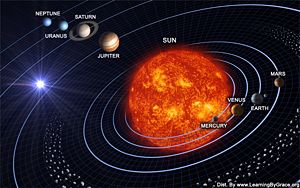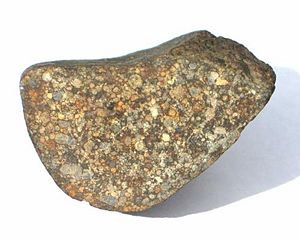Notes 1: Difference between revisions
No edit summary |
|||
| Line 55: | Line 55: | ||
The ''mean molecular weight'' is determined by | The ''mean molecular weight'' is determined by | ||
Other important quantities for consideration would be the mean molecular weight, <math> | |||
\mu_i = \frac{\sum_i{A_i Y_i}}{\sum_i Y_i} = \frac{\sum_i X_i }{\sum_i Y_i} = \frac{1}{\sum_i Y_i} \ | \mu_i = \frac{\sum_i{A_i Y_i}}{\sum_i Y_i} = \frac{\sum_i X_i }{\sum_i Y_i} = \frac{1}{\sum_i Y_i} \,</math>, the electron abundance,<math>Y_e = \sum_i Z_i Y_i \ ,</math>, and the electron number density, <math>n_e = Y_e \rho N_A \ .</math> | ||
</math> | |||
Y_e = \sum_i Z_i Y_i \ , | |||
</math> | |||
n_e = Y_e \rho N_A \ . | |||
</math> | |||
==Solar System Abundances== | ==Solar System Abundances== | ||
Revision as of 15:02, 22 January 2011
Atomic Nuclei
The atomic nucleus is quantum system composed of protons, neutron, and electrons who interact together to form a bound system. The forces acting on this system, strong force, weak force, the Coulomb force, and gravity, act on the system over various length scales that effect the overall distributions of the particle wavefunctions composing the nucleus. The strong force acts on length scales of m and below, primarily affecting the quark components of the previously mentioned nucleons. The weak force acts on a scale of m, acting on the range of the nucleons as it is the affect of boson exchange. The electric, i.e. Coulomb, force acting on the nuclei also acts at all ranges, modeling the interaction of the charged nucleon present in the system with one another. Finally, the gravitational force acts also acts at all ranges, and is the weakest of the four nuclear forces.
Within a given nucleus, denoted by , there are multiple levels of organizations. The protons and neutrons, closely bound by the nuclear forces, form a system whose energy levels are quantized, forming a shell structure hierarchy, for both the protons and neutron, whose energy levels often interact between one another. These nucleons are each composed of three individual particles known as quarks, bound together by the strong force.
The characteristics of the nuclides follow general trend lines based on both isomer, and isotope number, as seen by the nuclide chart posted here. A region of stability is observed, beyond which increases in proton or neutron number outside of the dripline (seen here in black) causes rapid decay of the nucleus in question.
Definitions for Abundances
To facilitate an understanding regarding the elements present in a given cosmological event or object, a framework must be established to properly measure the distribution of particles present. To this end, the nuclear abundance is presented as a measure of the number of a given isotope present in a quantity of measured element. This particle abundance is defined as follows:
where the sum is counted over all isotopes present in the data and is the particle's number density. This is often set logarithmically and normalized to the amount of hydrogen present, creating what is known as the relative particle abundance:
Furthermore, the mass fraction is defined to be the fraction of total mass of a sample that is composed of the particular nucleus in question, i.e.
Denoting the mass per baryon as
the particles number density can be defined by this baryon fraction and the density of the sample
The mean molecular weight is determined by
Other important quantities for consideration would be the mean molecular weight, , the electron abundance,, and the electron number density,
Solar System Abundances
The solar system is commonly believed to have formed from the collapse of a gaseous nebula. And this pre-solar nebula was thought to have an almost homogeneous abundance distribution of elements. There are three methods of probing the elemental abundances in the presolar nebula: The study of Materials on earth, the solar spectra, and unfractionated meteorites.
Earth materials
Examining materials on earth that have not undergone chemical fractionation gives a small glimpse at what elements were present in the presolar nebula.(Most isotopic compositions have not undergone chemical fractionation and are the main source of information for this.)
Solar Spectra
The Sun formed directly from the presolar nebula, and the study of it's spectrum can shed light on its composition. Of the outer layers, the photosphere is believed to be the most accurate representation of the elemental composition of the primordial solar system.
Meteorites
The analysis of presolar grains in a specific class of meteorites, called CI carbonaceous chondrites, can be perhaps the most precise measurement of this elemental abundance. These carbonaceous chondrites never fractionated because they did not experience high pressures or temperatures. There are only five known CI carbonaceous chondrites and they make up only an extremely small fraction of the meteorite.















